Page 720 of 814
7187-2. Steps to take in an emergency
C-HR_HEV_OM_Europe_OM10764E
Turn the compressor switch is
(off).
Pull out the power plug from the power outlet socket and then d is-
connect the nozzle from the valve on the tire.
Some sealant may leak when the hose is removed.
Press the button to release
pressure from the bottle.
Attach the cap to the nozzle.
16
17
Page 722 of 814
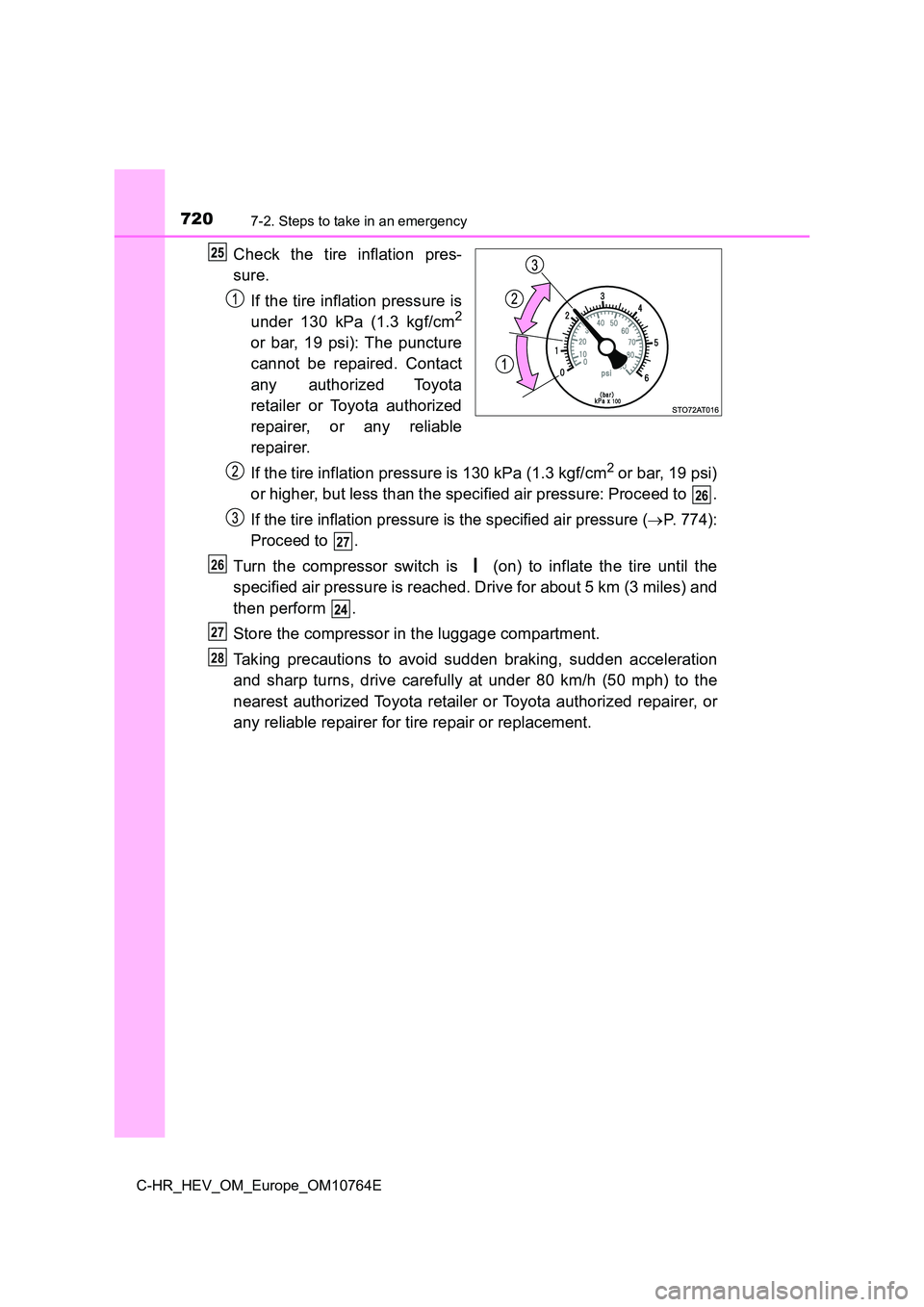
7207-2. Steps to take in an emergency
C-HR_HEV_OM_Europe_OM10764E
Check the tire inflation pres-
sure.
If the tire inflation pressure is
under 130 kPa (1.3 kgf/cm2
or bar, 19 psi): The puncture
cannot be repaired. Contact
any authorized Toyota
retailer or Toyota authorized
repairer, or any reliable
repairer.
If the tire inflation pressure is 130 kPa (1.3 kgf/cm2 or bar, 19 psi)
or higher, but less than the specified air pressure: Proceed to .
If the tire inflation pressure is the specified air pressure (P. 774):
Proceed to .
Turn the compressor switch is (on) to inflate the tire until t he
specified air pressure is reached. Drive for about 5 km (3 mile s) and
then perform .
Store the compressor in the luggage compartment.
Taking precautions to avoid sudden braking, sudden acceleration
and sharp turns, drive carefully at under 80 km/h (50 mph) to t he
nearest authorized Toyota retailer or Toyota authorized repaire r, o r
any reliable repairer for tire repair or replacement.
26
27
26
27
28
Page 723 of 814
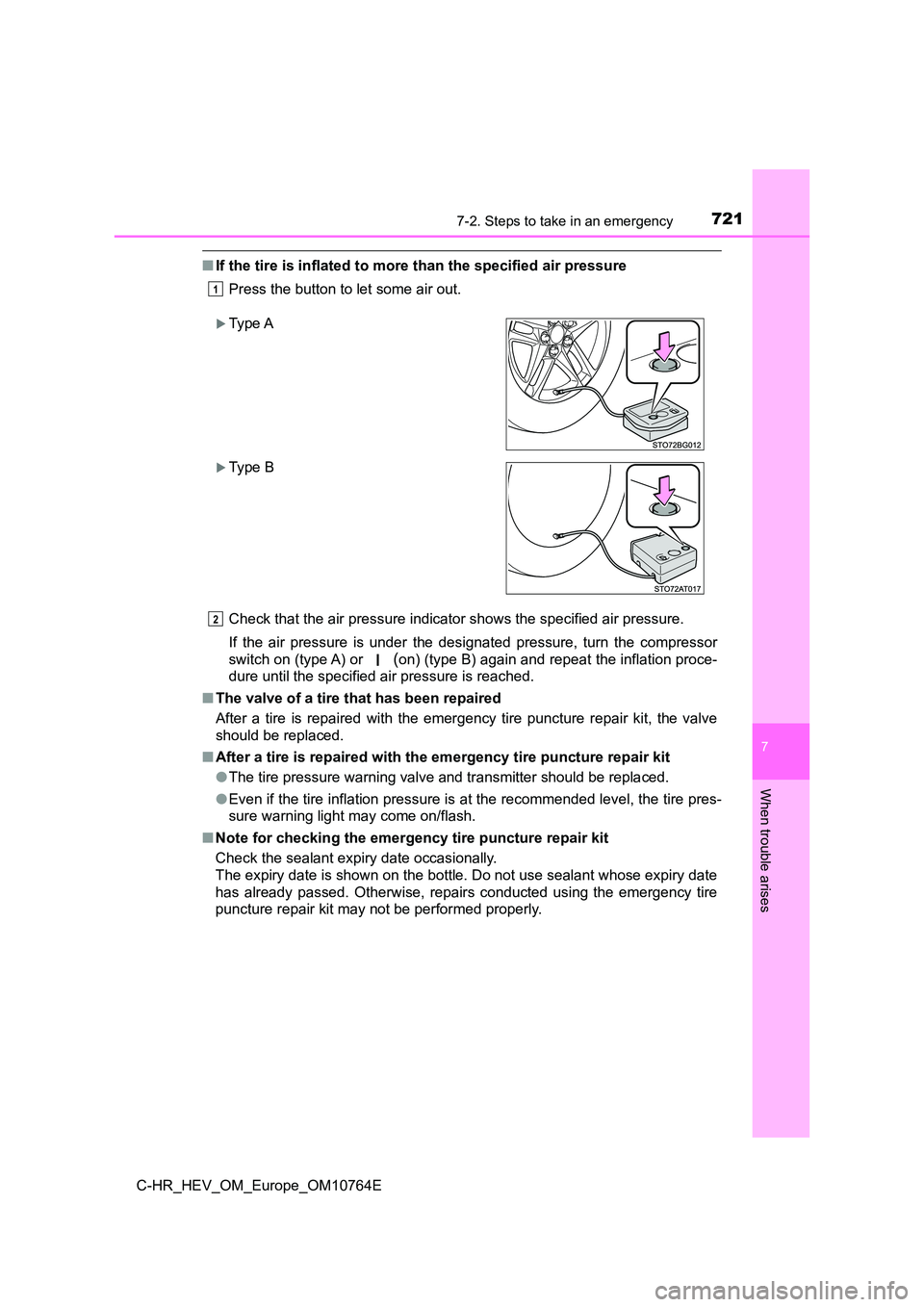
7217-2. Steps to take in an emergency
C-HR_HEV_OM_Europe_OM10764E
7
When trouble arises
■If the tire is inflated to more than the specified air pressure
Press the button to let some air out.
Check that the air pressure indicator shows the specified air p ressure.
If the air pressure is under the designated pressure, turn the compressor
switch on (type A) or (on) (type B) again and repeat the inflation proce-
dure until the specified air pressure is reached.
■ The valve of a tire that has been repaired
After a tire is repaired with the emergency tire puncture repai r kit, the valve
should be replaced.
■ After a tire is repaired with the emergency tire puncture repair kit
● The tire pressure warning valve and transmitter should be replaced.
● Even if the tire inflation pressure is at the recommended level, the tire pres-
sure warning light may come on/flash.
■ Note for checking the emergency tire puncture repair kit
Check the sealant expiry date occasionally.
The expiry date is shown on the bottle. Do not use sealant whos e expiry date
has already passed. Otherwise, repairs conducted using the emer gency tire
puncture repair kit may not be performed properly.
1
Type A
Type B
2
Page 724 of 814
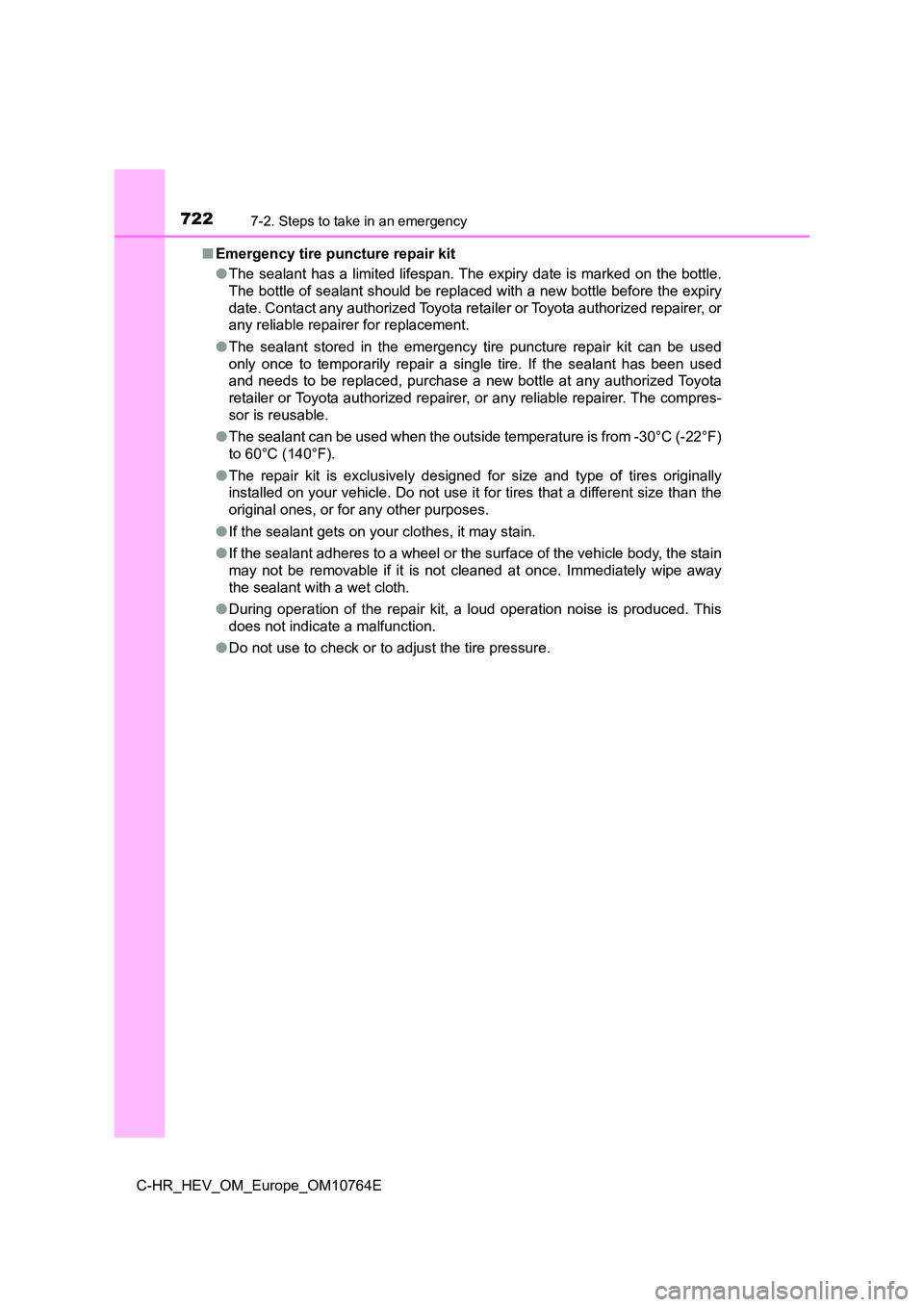
7227-2. Steps to take in an emergency
C-HR_HEV_OM_Europe_OM10764E
■ Emergency tire puncture repair kit
● The sealant has a limited lifespan. The expiry date is marked on the bottle.
The bottle of sealant should be replaced with a new bottle befo re the expiry
date. Contact any authorized Toyota retailer or Toyota authoriz ed repairer, or
any reliable repairer for replacement.
● The sealant stored in the emergency tire puncture repair kit can be used
only once to temporarily repair a single tire. If the sealant h as been used
and needs to be replaced, purchase a new bottle at any authoriz ed Toyota
retailer or Toyota authorized repairer, or any reliable repaire r. The compres-
sor is reusable.
● The sealant can be used when the outside temperature is from -30°C (-22°F)
to 60°C (140°F).
● The repair kit is exclusively designed for size and type of tires originally
installed on your vehicle. Do not use it for tires that a diffe rent size than the
original ones, or for any other purposes.
● If the sealant gets on your clothes, it may stain.
● If the sealant adheres to a wheel or the surface of the vehicle body, the stain
may not be removable if it is not cleaned at once. Immediately wipe away
the sealant with a wet cloth.
● During operation of the repair kit, a loud operation noise is produced. This
does not indicate a malfunction.
● Do not use to check or to adjust the tire pressure.
Page 726 of 814
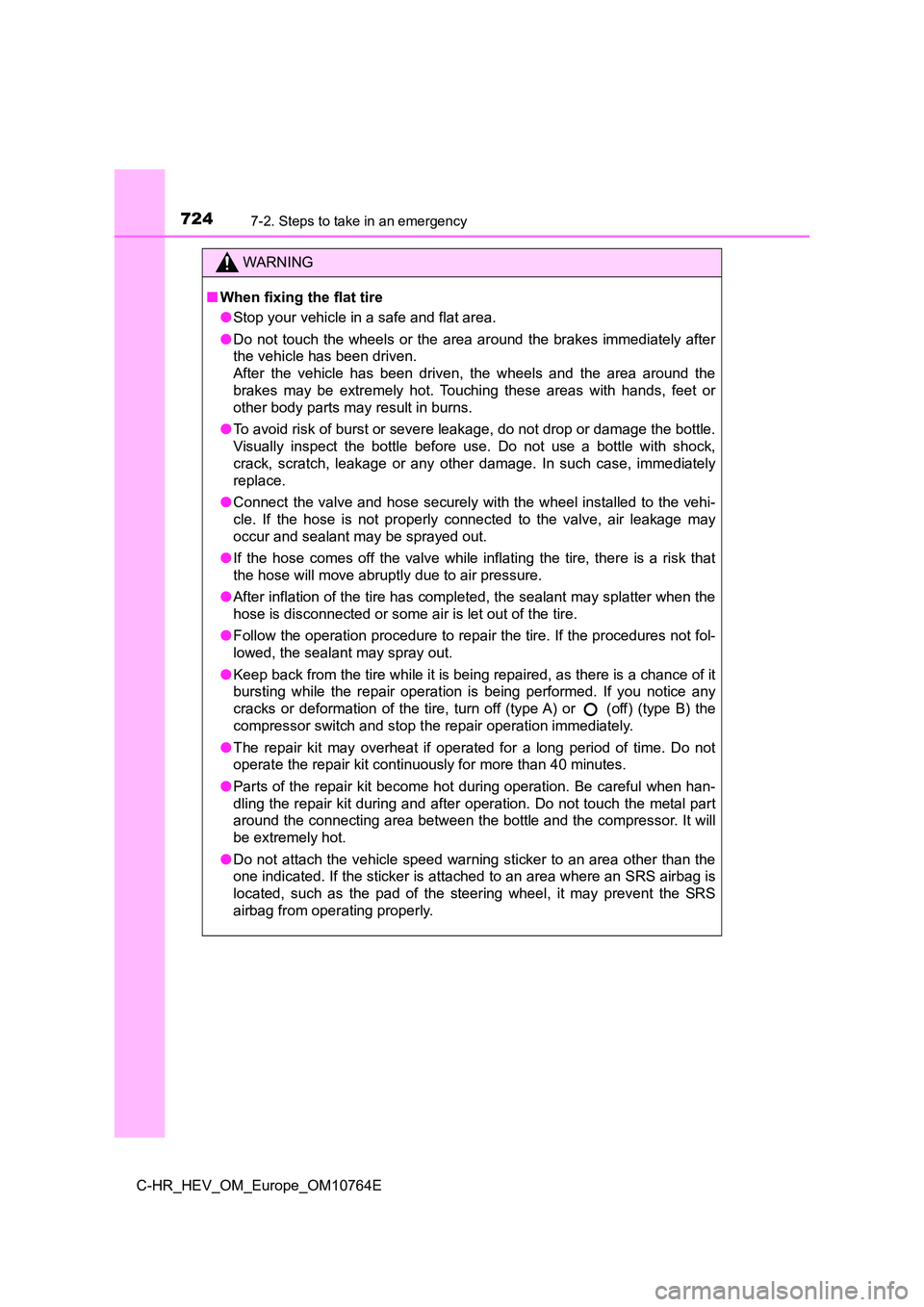
7247-2. Steps to take in an emergency
C-HR_HEV_OM_Europe_OM10764E
WARNING
■When fixing the flat tire
● Stop your vehicle in a safe and flat area.
● Do not touch the wheels or the area around the brakes immediately after
the vehicle has been driven.
After the vehicle has been driven, the wheels and the area arou nd the
brakes may be extremely hot. Touching these areas with hands, f eet or
other body parts may result in burns.
● To avoid risk of burst or severe leakage, do not drop or damage the bottle.
Visually inspect the bottle before use. Do not use a bottle wit h shock,
crack, scratch, leakage or any other damage. In such case, imme diately
replace.
● Connect the valve and hose securely with the wheel installed to the vehi-
cle. If the hose is not properly connected to the valve, air le akage may
occur and sealant may be sprayed out.
● If the hose comes off the valve while inflating the tire, there is a risk that
the hose will move abruptly due to air pressure.
● After inflation of the tire has completed, the sealant may splatter when the
hose is disconnected or some air is let out of the tire.
● Follow the operation procedure to repair the tire. If the procedures not fol-
lowed, the sealant may spray out.
● Keep back from the tire while it is being repaired, as there is a chance of it
bursting while the repair operation is being performed. If you notice any
cracks or deformation of the tire, turn off (type A) or (off) (type B) the
compressor switch and stop the repair operation immediately.
● The repair kit may overheat if operated for a long period of time. Do not
operate the repair kit continuously for more than 40 minutes.
● Parts of the repair kit become hot during operation. Be careful when han-
dling the repair kit during and after operation. Do not touch t he metal part
around the connecting area between the bottle and the compresso r. I t w il l
be extremely hot.
● Do not attach the vehicle speed warning sticker to an area other than the
one indicated. If the sticker is attached to an area where an S RS airbag is
located, such as the pad of the steering wheel, it may prevent the SRS
airbag from operating properly.
Page 727 of 814
7257-2. Steps to take in an emergency
C-HR_HEV_OM_Europe_OM10764E
7
When trouble arises
WARNING
■Driving to spread the liquid sealant evenly
Observe the following precautions to reduce the risk of acciden ts.
Failing to do so may result in a loss of vehicle control and ca use death or
serious injury.
● Drive the vehicle carefully at a low speed. Be especially careful when turn-
ing and cornering.
● If the vehicle does not drive straight or you feel a pull through the steering
wheel, stop the vehicle and check the following.
• Tire condition. The tire may have separated from the wheel.
• Tire inflation pressure. If the tire inflation pressure is 130 kPa (1.3 kgf/cm2
or bar, 19 psi) or less, the tire may be severely damaged.
Page 728 of 814
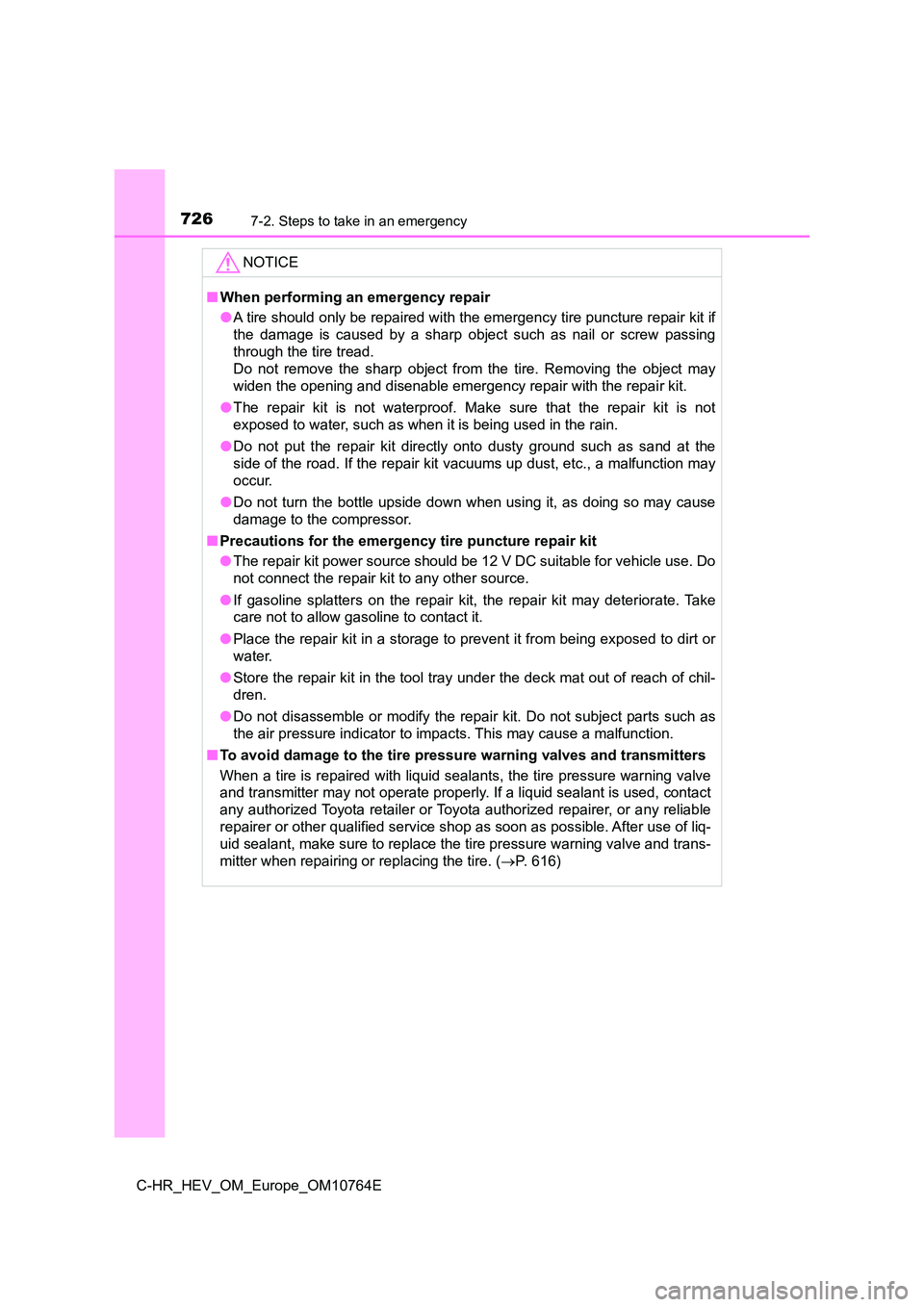
7267-2. Steps to take in an emergency
C-HR_HEV_OM_Europe_OM10764E
NOTICE
■When performing an emergency repair
● A tire should only be repaired with the emergency tire puncture repair kit if
the damage is caused by a sharp object such as nail or screw pa ssing
through the tire tread.
Do not remove the sharp object from the tire. Removing the obje ct may
widen the opening and disenable em ergency repair with the repair kit.
● The repair kit is not waterproof. Make sure that the repair kit is not
exposed to water, such as when it is being used in the rain.
● Do not put the repair kit directly onto dusty ground such as sand at the
side of the road. If the repair kit vacuums up dust, etc., a ma lfunction may
occur.
● Do not turn the bottle upside down when using it, as doing so may cause
damage to the compressor.
■ Precautions for the emergency tire puncture repair kit
● The repair kit power source should be 12 V DC suitable for vehicle use. Do
not connect the repair kit to any other source.
● If gasoline splatters on the repair kit, the repair kit may deteriorate. Take
care not to allow gasoline to contact it.
● Place the repair kit in a storage to prevent it from being exposed to dirt or
water.
● Store the repair kit in the tool tray under the deck mat out of reach of chil-
dren.
● Do not disassemble or modify the repair kit. Do not subject parts such as
the air pressure indicator to impacts. This may cause a malfunc tion.
■ To avoid damage to the tire pressure warning valves and transmitters
When a tire is repaired with liquid sealants, the tire pressure warning valve
and transmitter may not operate properly. If a liquid sealant i s used, contact
any authorized Toyota retailer or Toyota authorized repairer, o r any reliable
repairer or other qualified service shop as soon as possible. A fter use of liq-
uid sealant, make sure to replace the tire pressure warning val ve and trans-
mitter when repairing or replacing the tire. ( P. 616)
Page 740 of 814
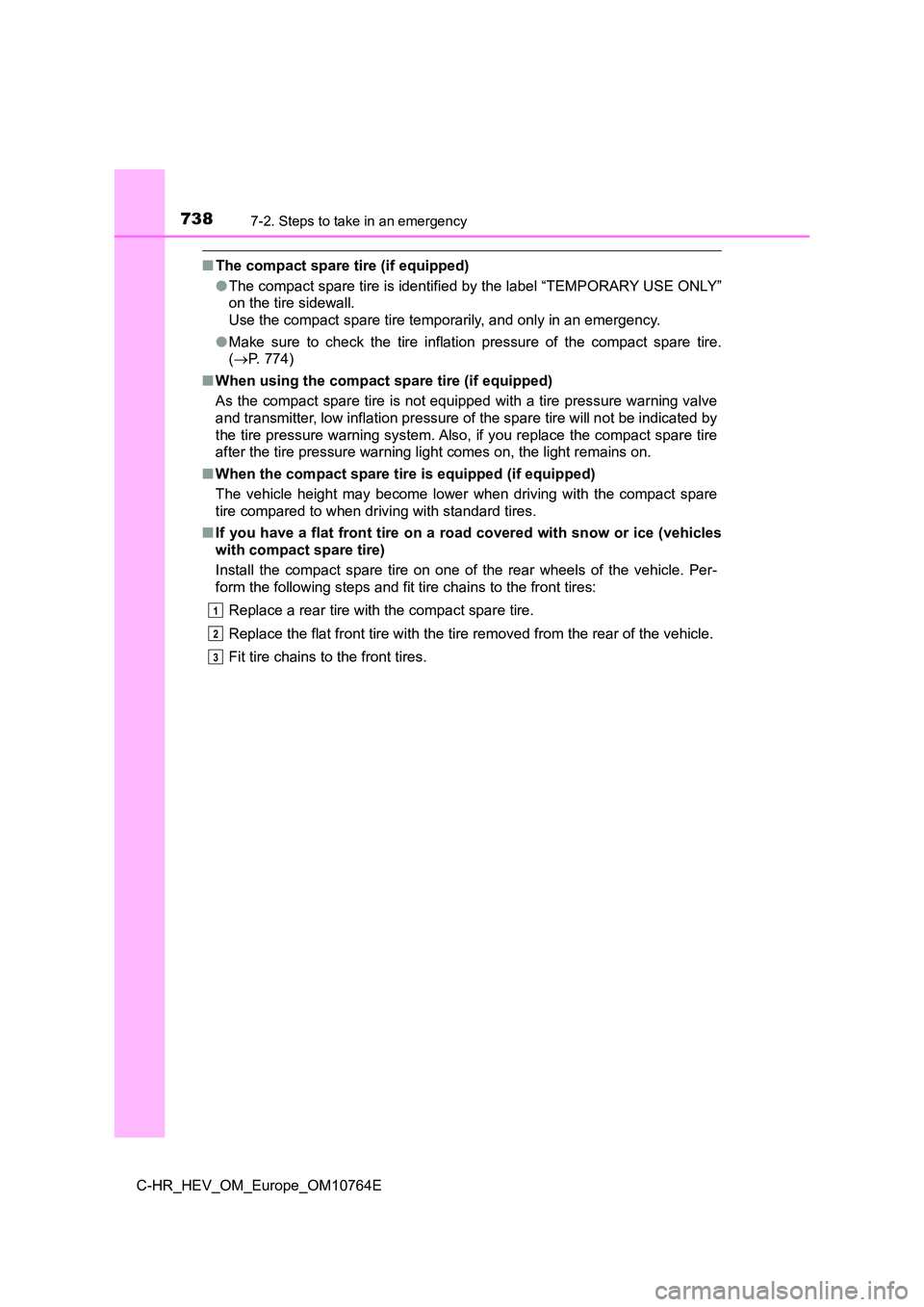
7387-2. Steps to take in an emergency
C-HR_HEV_OM_Europe_OM10764E
■The compact spare tire (if equipped)
● The compact spare tire is identified by the label “TEMPORARY USE ONLY”
on the tire sidewall.
Use the compact spare tire temporarily, and only in an emergenc y.
● Make sure to check the tire inflation pressure of the compact spare tire.
( P. 774)
■ When using the compact spare tire (if equipped)
As the compact spare tire is not equipped with a tire pressure warning valve
and transmitter, low inflation pressure of the spare tire will not be indicated by
the tire pressure warning system. Also, if you replace the comp act spare tire
after the tire pressure warning light comes on, the light remai ns on.
■ When the compact spare tire is equipped (if equipped)
The vehicle height may become lower when driving with the compa ct spare
tire compared to when driving with standard tires.
■ If you have a flat front tire on a road covered with snow or ice (vehicles
with compact spare tire)
Install the compact spare tire on one of the rear wheels of the vehicle. Per-
form the following steps and fit tire chains to the front tires :
Replace a rear tire with the compact spare tire.
Replace the flat front tire with the tire removed from the rear of the vehicle.
Fit tire chains to the front tires.
1
2
3